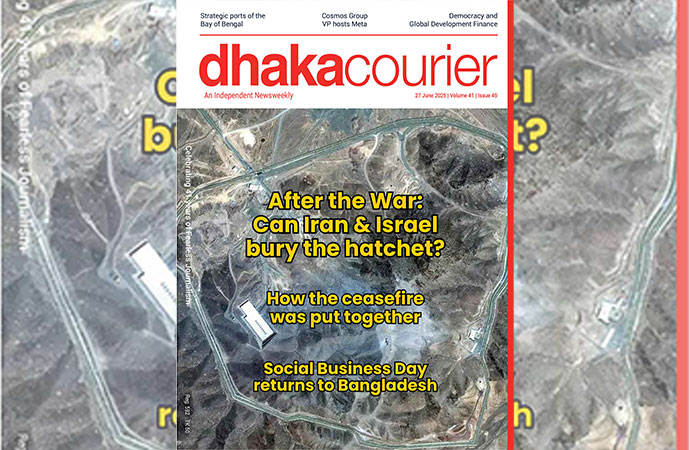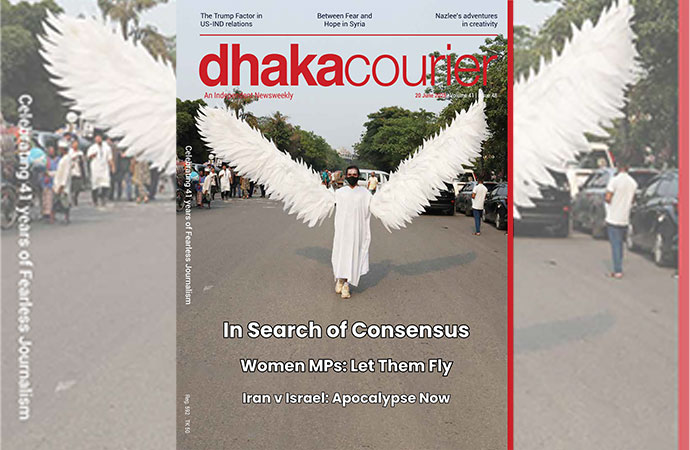Featured 2

I met Kalidas Karmakar (affectionately known as Kali da) for the last time at a dinner in International Club, Gulshan. On that occasion, he showed me some of his recent paintings on his mobile. The paintings were vibrant but looked rigid, I told him. He invited me to come to his studio-cum-apartment in Eskaton. But after that I became busy and couldn't find enough time to visit him. It can be easily said that the artist was energetic, youthful and strong - and could think many things in his brain simultaneously. He was dynamic and had command over different fields as he did print, painting, drawing, performing art and installation simultaneously.
Kalidas visited many countries and showcased his artworks at many reputed galleries in different parts of the world. For that reason, he gathered many experiences and did experiments on diverse working processes, materials and distinctive styles. He always tried to make an impression of internationalism through his creations.
Kali da was one of the advisers of Cosmos Gallery. The printmaking department of the gallery was founded by very own hands of the artist, for which he had always shown great dedication. Many printmakers from different institutions have learned techniques, methods from Kali da. He was engaged for the progress of the gallery till his death.
This is an unquestionable assessment that 21st century art can be categorised into two distinct movements. One can be called conceptual, as it is characterised by works of art that deal with socially and politically engaging issues. The other, the foremost concept of this century's art is pure abstraction in its diverse styles. Kalidas' work represents the latter one. He had felicity enough to identify himself with his apparently harmonised and standalone working styles. Steadfast may be the term more appropriate in denoting his stylistic approach to preserve the personal hallmark in his works.
As an intense onlooker during his lifetime, Kalidas could closely observe the transforming socio-political and economical conditions of the society. Generally he set out as a naturist and landscape painter. In the early stages of his career, nature played a major role in his works. The painter felt that the nature has an endless source of splendour, mystery and anonymity. He discovered inspiration in the elaborate detailing of glimpses like light filtering through the leaves, sound of river's wave, the silence of nature, a drop of rain, singing crickets, dense foliage, the play of light and shadow in nature, flora and fauna as well as many others. Each of these elements contained a new story for him.
I can confidently say that Kalidas Karmakar's images reflect anger, frustration, suffering, death, destruction and his subjects encapsulate the misery of common Bangladeshis in times of war, floods, cyclones, famines, political and economical turmoil.
As a painter, Kalidas felt that he had a responsibility toward his country. He recorded time, history and incidents in our urban and rural lives. Now after his demise we can still see that his language remains distinctive as he used the canvas to protest cruelty, inequality, political chaos, poverty and violence in our daily lives.
When Kalidas used to get engrossed with his paintings, he lost himself. Without fear, he was known to nurture enough courage to destroy his labourious productions if he found them unsatisfactory and thus create a new pattern, as the world of painting surrounded him from all possible dimensions. He most certainly did not seem to relent and on the contrary could not help but breathe the life in each painting. Likewise Kalidas was capable of applying colours and he created forms, lines and compositions. He used to put layer upon layer of paint and drew forms and compositions, until he felt that he had achieved what he was striving for. The outcome was a contemplative, subtly balanced arrangement of colours and space that even now draws an art enthusiast's eyes.
In his long and chequered life, Kalidas had gradually transformed himself into an abstract expressionist. His works were form and colour-oriented. He prefered bold brush strokes, bright colours, light and shade. In his use of materials and tints, he frequently opted for the bold and natural. Kalidas had started to increasingly becoming serious to impart messages through his paintings and he was becoming more innovative, using space to increasingly interact with faces, figures and objects on his canvas. As of now, these works simultaneously showcase signs of technical excellence and a mature intellect.
For his life-long attachment to art, the painter-printmaker received Ekushey Padak, Shilpakala Padak, Sultan Padak and many other prestigious awards.

























Leave a Comment
Recent Posts
Cosmos Group VP Nahar Khan hos ...
A visiting delegation from Meta, the parent company of Facebook, Insta ...
Break the gloom, build a bette ...
Emphasising the transformative power of social business and its strong ...
‘Mobocracy’ must not prevail
The US Supreme Court allowed the Trump administratio ..
Germany dependable partner in our development journe ..
15th edition of Social Business Day: Prof Yunus to j ..